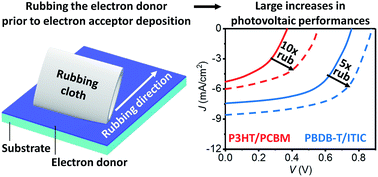Controlling the concentration gradient in sequentially deposited bilayer organic solar cells via rubbing and annealing†
Abstract
We elucidate the formation mechanism of adequate vertical concentration gradients in sequentially deposited poly(3-hexylthiophene-2,5-diyl) (P3HT) and phenyl-C61-butyric acid methyl ester (PCBM) bilayer solar cells. Using advanced analytical techniques, we clarify the origins of the enhanced photovoltaic performances of as-deposited and annealed bilayer P3HT/PCBM organic solar cells upon P3HT layer rubbing prior to PCBM deposition. Energy-dispersive X-ray spectroscopy reveals the individual effects of rubbing and annealing on the formation of adequate concentration gradients in the photoactive layers. Repetitive rubbing of P3HT strongly affects the active layer nanomorphology, forming an intermixed layer in the as-deposited devices which is retained after the annealing process. Infrared p-polarized multiple-angle incidence resolution spectrometry measurements indicate that rubbing induces a minor reorganization of the P3HT molecules in the polymer-only thin films towards face-on orientation. However, the deposition of the upper PCBM layer reverts the P3HT molecules back to their original orientation. These findings suggest that the formation of an adequate concentration gradient upon rubbing corresponds to the dominant contribution to the improved photovoltaic characteristics of rubbed bilayer organic solar cells. Using the reference low bandgap copolymer PCDTBT, we demonstrate that rubbing can be successfully applied to increase the photovoltaic performances of PCDTBT/PCBM organic solar cells. We also demonstrate that rubbing can be an efficient and versatile strategy to improve the power conversion efficiency of non-fullerene solar cells by using the reference materials in the field, PBDB-T and ITIC.



 Please wait while we load your content...
Please wait while we load your content...